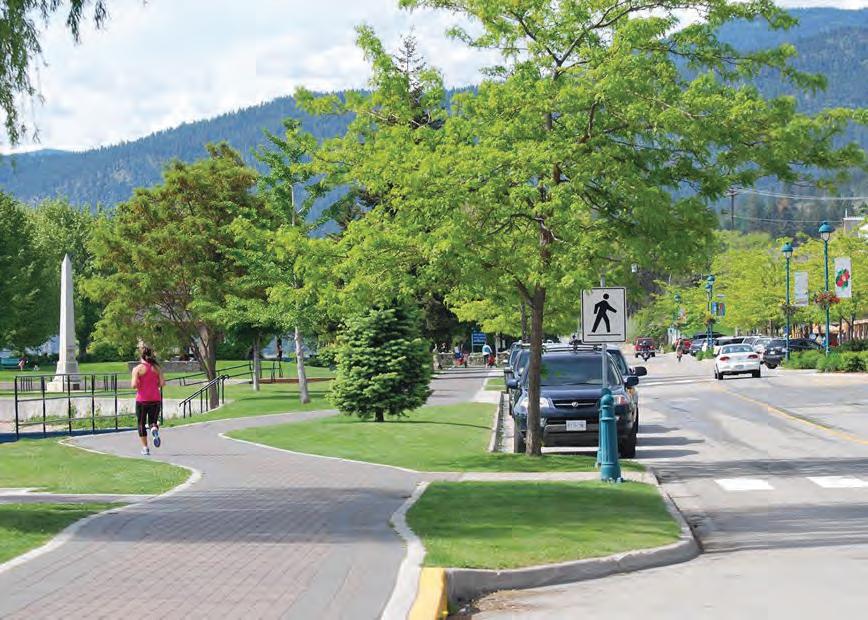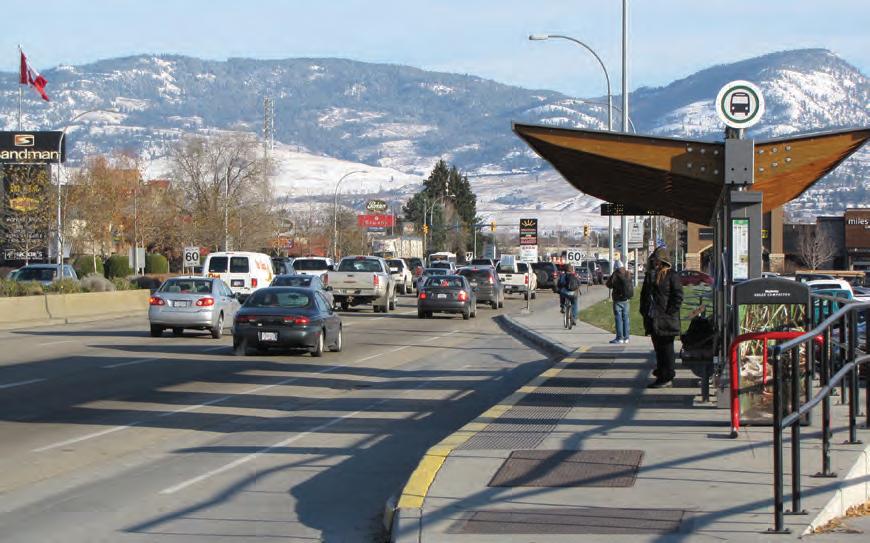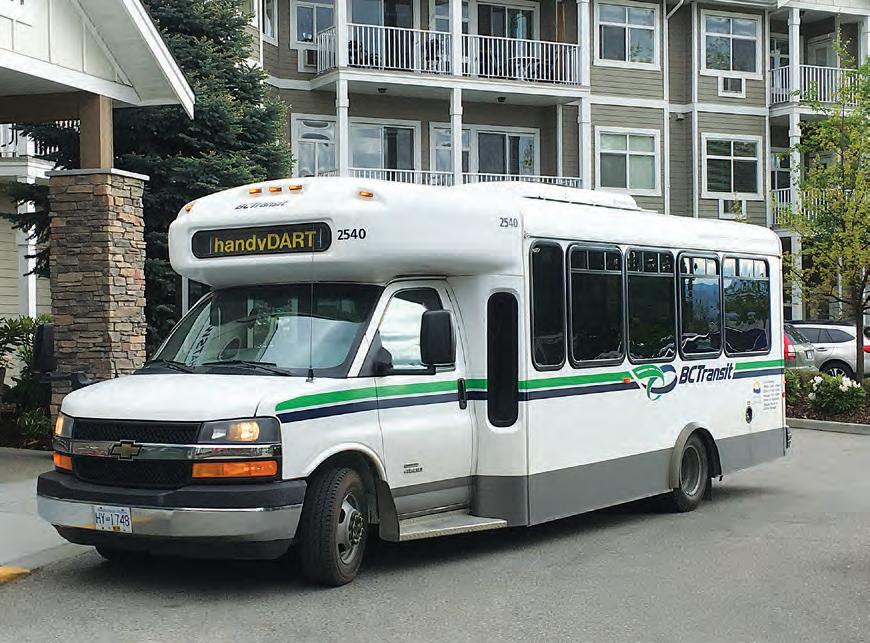
4 minute read
Transportation and Mobility
We will promote transportation and land use approaches that enhance movement throughout the region and reduce our collective reliance on vehicles
Regional planning is critical in improving connections and ensuring residents have transportation options to significant work and community hubs across the region.
Advertisement
Safe Routes 4 Schools
If you’ve ever driven past a school in the Central Okanagan first thing in the morning, or after final bell in the afternoon, you know about the importance of school zones.
There are parents, parents in vehicles and of course students making their way to and from their day of classes.
That’s why the Regional Air Quality program in collaboration with the Sustainable Transportation Partnership Central Okanagan is encouraging the Clean Air and Safe Routes 4 Schools program.
The Air Quality Coordinator assists with developing a School Travel Plan for participating schools and coordinates stakeholders including parents, Interior Health, RCMP, School District 23 and local government departments. They work together to create a viable plan that addresses safety concerns and necessary infrastructure improvements and engages staff, students and parents of the school involved in improving air quality.
Once in place and on the ground, these plans reduce vehicle traffic and harmful vehicle emissions while increasing the number of students safely using active transportation methods like walking and cycling.
In 2019, School Travel plans were completed for Raymer and Pearson elementary schools.
Pedalling And Walking Supported
The Regional Bicycling and Trails Master Plan will provide an update to the Regional Active Transportation Master Plan that was adopted in 2012 and presented a future bicycle and pedestrian network to provide safe and convenient travel options, connecting significant destinations across the region to ensure a safe and comfortable experience for people walking and cycling. In the years since the plan was created, many active transportation connections have been completed and additional active transportation plans have been developed by jurisdictions within the region. Updating the 2012 plan to align with recent changes will help focus the vision for bicycle and trail connections throughout the Central Okanagan.
Bike To Work Week
In 2019, more than 2,300 Central Okanagan residents registered for Bike to Work Week and collectively travelled 91,500 kilometres by bike, saving nearly 20,000 kilograms of greenhouse gases. To assist with planning for Bike to Work Week 2020, participants were invited to complete a short questionnaire on what motivates them to participate, what they like about the event and what can make this event even better.
Regional Transportation Plan
The Regional Transportation Plan is a long-range plan that will help shape the future of the Central Okanagan region by identifying the transportation investments that will be needed over the next 20 years.

Transportation across the region provides a vital connection to jobs, markets, health care, education, recreation, shopping, emergency services and family and friends.
By 2040, population in the Central Okanagan is expected to increase by 38% to approximately 277,000 people. The issues affecting all our communities – economic competitiveness, air quality, climate change, goods movement, emergency response, public health and quality of life, are all directly impacted by the transportation choices we make today. Future population growth provides both a challenge and an opportunity to find more economically and environmentally responsible ways to move goods and people across our region.
By working collaboratively, we can ensure that regional transportation supports a strong economy and quality of life in the Central Okanagan, both now and into the future.
During 2019, a ‘Let’s Talk Transportation’ public engagement event and questionnaire helped understand what resident’s value and provided information on potential transportation options. The project team has been analysing the results in order to refine and screen possible options.
The Regional Transportation Plan is being coordinated with the Kelowna Transportation Master Plan, the Kelowna Official Community Plan, the Okanagan Gateway Transportation Study, and the Central Okanagan Planning Study, among other current long-range planning efforts. Any prioritized options for regional transportation programs and investments that are made in the Regional Transportation Plan will be coordinated with these other long-range plans.
It’s anticipated the plan will be completed during 2020.
Transportation Talk
In spring 2019, the regional transportation planning team launched Let’s Talk Transportation – a public engagement event and questionnaire designed to understand the values of Central Okanagan residents and obtain input on potential transportation options.

Since then, the project team has been analyzing the results of the engagement and conducting a corridor-level analysis to refine and screen the options. During the fall the regional councils received an update on the refined options and plan status. In addition, a workshop on Sustainable Transportation Partnership Central Okanagan governance was held for the Local Government Advisory Board. Completion of the plan is anticipated for 2020.
Transit Services Upgraded
The fall of 2019 saw upgrades to Kelowna Regional Transit System. Three new routes started serving West Kelowna and Westbank First Nation. Service levels on routes going to and from secondary and post-secondary schools were reinstated for the fall to reflect increased demand for transit at that time of year. Other adjustments included improved Sunday service and weekday evening service for route 97 Okanagan on the Westside, improved midday service on weekdays and Sunday service for the route 8 University/OK College, and weekday peak hour trips extended to serve the Ellison area on route 23 Lake Country.
HOW DO YOU GET AROUND?
The Regional Household Travel Survey was conducted during 2019. The results of this study are critical for looking at changes in residents travel patterns over time and will help with achieving targets such as shifts in transportation modes and options.
Gateway Plan
The Okanagan Gateway Transportation Study will define future projects, programs and policies that will improve connections to Kelowna International Airport and UBC Okanagan. It will support the vision of Kelowna International Airport, the University of British Columbia Okanagan campus and the surrounding area as a growing, vibrant and connected hub that benefits the whole region. It will be coordinated with and will help inform the Regional Transportation Plan.
2020 TRANSPORTATION AND MOBILITY INITIATIVES TRANSIT AND PROGRAMS DELIVERY
• Transit management
• Enhancing partnership with BC Transit

• Sustainable transportation demand management (TDM) programs
• HandyDart service management
• Community transit events (e.g. Santa Bus, Stuff a Bus)
• Transit infrastructure implementation
• Major transit infrastructure proposals
• NextFare: new technology for paying transit fairs
STRATEGIC TRANSPORTATION PLANNING
• Regional Transportation Plan - Including transit infrastructure plan and prioritization (regional transit infrastructure capital plan)
• Regional Bicycling and Trails Master Plan
• Regional Community Capacity TDM Program
• Regional Disruptive Mobility Strategy - Aims to identify, analyze, and plan for the impact of technological advancements and trends in transportation on the future of the Central Okanagan.A focus will be placed on the impact of self-driving vehicle technology within the local context.
• Okanagan Gateway Transportation Study (conceptual designs)
Governance
• Evaluation of the governance and funding for the Sustainable Transportation Partnership of the Central Okanagan.









